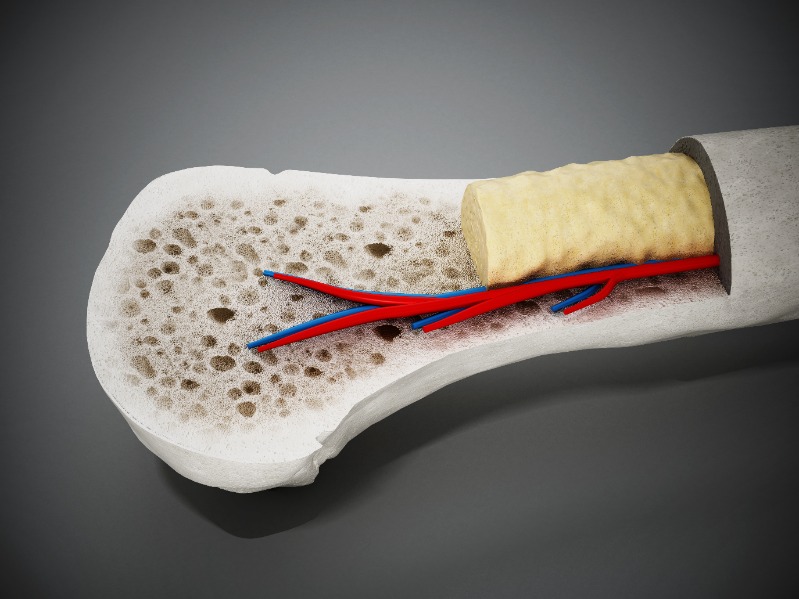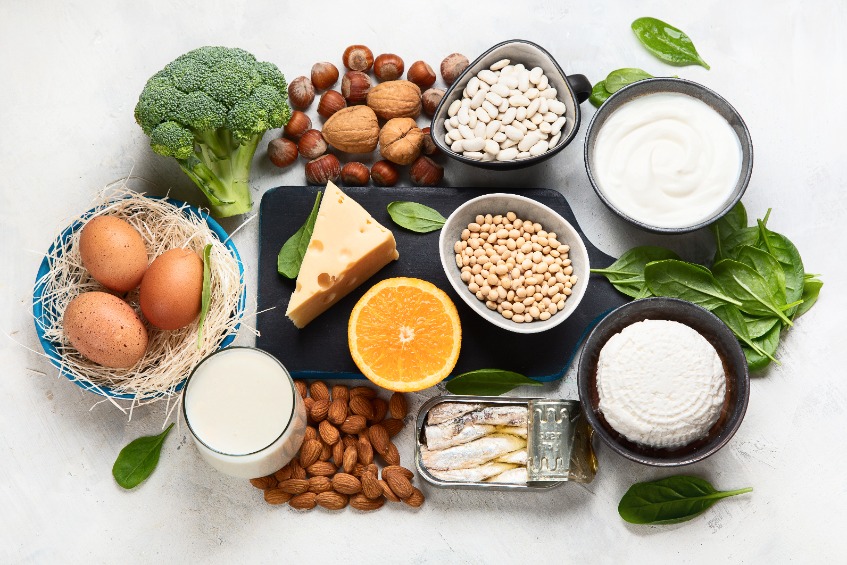Healthy Bones – The body does not make calcium!
Integrative Health – February 2023
Strong Bones for Life!
An infant is born with 270 bones. Some bones fuse, creating 206 bones by 25 years old. While bone is living tissue, we don’t pay much attention to it until we break one or are diagnosed with osteopenia or osteoporosis.
The function of bones is to shape and support our body, protect organs, store minerals, and provide marrow for developing and storing blood cells.
To help our bones stay strong through self-care, we need to know what bones are made of.

Bone cells play a significant role in bone health. They are called:
- Osteoblast – forms new bone tissue
- Osteoclast – absorbs and removes unwanted tissue
- Osteocyte – maintains bone as living tissue
- Hematopoietic – produces red blood cells, white blood cells, and platelets
Bone is 40% collagen protein, of which 90% is Type 1 collagen protein, providing a soft framework. Almost 70% of bone is bone mineral. Calcium phosphate is a mineral that strengthens and hardens the bones. Ninety-nine percent of the body’s calcium is in the bones and teeth, and one percent is in the blood. The body does not make calcium, meaning a nutritional intake is key to maintaining strong bones for life.

Components of Maintaining Strong Bones
Natural Food is the preferred way to get calcium into the body; however, the average diet usually does not contain enough food base calcium. An adult needs 1000mg of calcium per day, increasing to 1200 mg over the age of 50 for women.
To give you an idea of how much calcium is in food, a glass of organic grass-fed milk contains 300 mg of calcium, an egg 25mg of, one cup of broccoli 180mg, and one cup of pinto beans 75mg. I recommend avoiding calcium-enriched food because you don’t know what kind of calcium is used. See below for more food choices.
https://www.ucsfhealth.org/education/calcium-content-of-foods
The best form of collagen is grass-fed, hydrolysate, tasteless, and easy to mix in cold and warm liquid. For example, you can put it in coffee, a cup of soup, oatmeal, and yogurt. My favorite brand can be found at https://greatlakeswellness.com.
There are only three types of calcium with a very high absorption that I will recommend. For bones, calcium orotate balanced with magnesium is one of the best. The absorption of calcium orotate is around 90%, whereas the absorption rate of other forms of calcium averages around 35%. Vegan-friendly and GMO-free, a good calcium supplement can be found at
https://globalhealing.com/collections/supplements/products/calcium-magnesium.
Co-factors Vitamin D3 help absorb calcium into the body, and Vitamin K2 helps to reduce calcium loss in bones. A great source of Vitamin D3 is 15 minutes of sunlight on as much skin as you can manage. Vitamin K2 is then taken separately. Or a Vitamin D3/K2 supplement will suffice if that’s not possible.
Exercise is key to building bone when we are younger and essential for maintaining bone strength when we are older. Exercise helps to build dense bones.
Bone destroyers
Estrogen protects bones by regulating osteoclasts. A post-menopause reduction in estrogen naturally decreases osteoblasts (new bone formation cells) and increases osteoclasts (removal of tissue)
Stress increases cortisol which decreases osteoblasts (new bone formation cells) and increases osteoclasts (removal of tissue)
Too much salt has been associated with calcium loss, but it may not be the culprit. The reference below concludes that sugar may be more of a risk factor when overconsumed.
Smoking reduces the blood supply to the bones and decreases calcium absorption.
Alcohol interferes with the pancreas and its absorption of calcium and vitamin D.
The medications listed in this reference can decrease bone health.
https://americanbonehealth.org/bone-health/medications-that-can-be-bad-for-your-bones-2/
We sense when something is not quite in balance with our body. However, we don’t even think about bone health until something happens, like a fracture or a diagnosis of osteoporosis. Maintaining bone health is easy and should be considered by anyone over 40. The best preventive measures are exercise, nutrition, supplements, stress reduction, and paying attention to the bone destroyers.
I invite you to take a look at my Master Program, “Aging Strong to 100 and Beyond,” at qpwellness.com for in-depth information on maintaining the best health and vitality possible, including bones and osteoporosis.
To your health,
Dr. Gerda
Doctor of Natural Medicine and Holistic Cancer Consultant
Disclaimer: The information in this blog is intended for educational purposes only. As a Board-Certified Doctor of Natural Medicine, I do not diagnose or treat disease, an area well attended by licensed physicians. Instead, I identify healing opportunities within the body. Once identified, function and health may be restored by correcting the underlying causes and conditions of health challenges. Rebalancing the body’s systems can be a proven stabilizer adjunctive to medical protocols for serious medical conditions. Everyone is an individual, and not all recommendations may be appropriate. Exercising due diligence and consulting your physician before engaging in alternative concepts or protocols is recommended.
References
3. https://www.hopkinsmedicine.org/health/wellness-and-prevention/anatomy-of-the-bone
4. https://www.bones.nih.gov/health-info/bone/bone-health/what-is-bone
5. https://www.medicalnewstoday.com/articles/325903
6. https://www.healthline.com/nutrition/collagen-benefits
7. https://www.forbes.com/health/body/best-collagen-powders/
